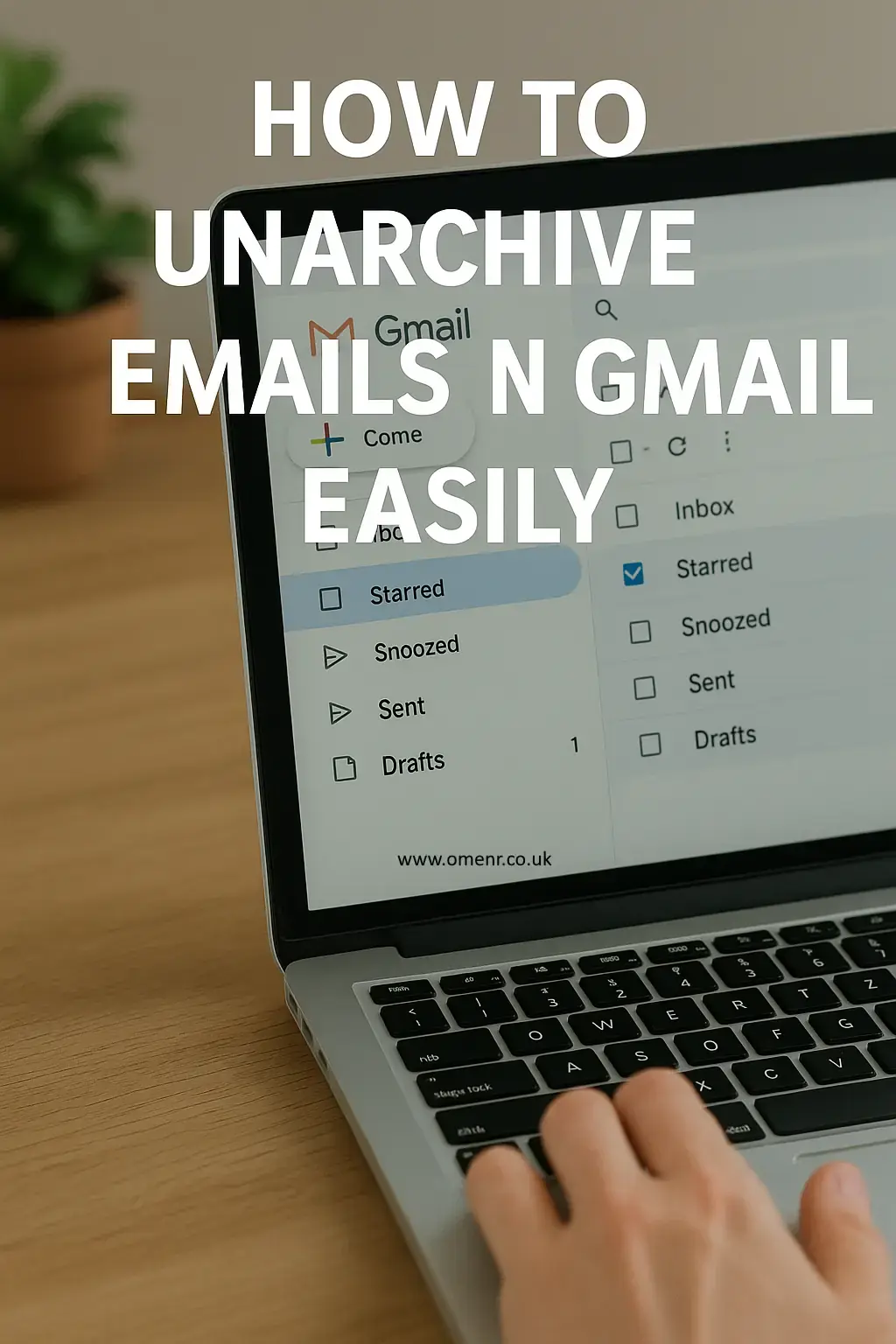Do you feel like you are drowning in a sea of emails, and important messages are lost somewhere under your Gmail archive? You are not the only one! Every time you need that vital job email or the picture you were supposed to send family members, it can seem like a needle-in-a-haystack process to unarchive emails. But you don't need to worry, getting those lost treasures back in your inbox is simpler than you imagine. Let us take this step-by-step guide to unarchiving emails and make sure no email falls under the radar anymore in Gmail. Goodbye to email confusion and welcome to a neat inbox, here we go!
Introduction to Unarchiving Emails in Gmail
Have you ever lost critical emails deep in the recesses of your Gmail account and forgotten that you sent that mail? It is to us all what it is. Archiving is a great time saver when it comes to cleaning up your inbox, but it is ultimately disastrous to find that it has killed your messages at the most opportune time. So, you open your Gmail to find some of those precious gems among the archived messages, but you still wonder how you could unarchive your Gmail messages and see them again. It will be a step-by-step guide to disclose all secrets on how to restore all your archived emails and to make your digital life orderly again. A nostalgic project update or a favourite text message of a loved one has to be reclaimed, and it all starts with a simple one!
Understanding the Archive Feature in Gmail
The archive tool included in Gmail is useful to facilitate easy management of your inbox without deleting valuable emails. Archiving will also enable you to store messages that you do not wish to read in your main inbox, but which you can access at any time. By archiving your email, it disappears from the main view and stays in the folder marked "All mail". This does not mean archived emails are lost, but they are just stored where it is easy to navigate through.
This feature is particularly useful to people who desire to maintain an uncluttered and sorted inbox. By enabling a user to concentrate on present tasks and maintain access to previous communications, it reduces the level of stress. Knowing about all these features should help you be more efficient in dealing with your emails, and it may become much easier to find what you need, when you need it, just in time.
Why You Might Need to Unarchive Emails
The unarchiving of emails may be necessary in cases where one may want to refer back to some important discussions. On certain occasions, this information contained in archived emails can be vital in the activities at hand or consultations. You may have gotten a serious attachment that you now need. Perhaps, it is a presentation or a contract-- being able to access it again is crucial in your job flow.
Also, former correspondence might shed light on the situation at hand. The need to repeat mistakes or improve their productivity is effectively prevented by referring to past decisions. In emergencies, there would be a need to access certain information swiftly. An archived message may be used to convey vital information that can quickly solve burning problems.
Old communication with colleagues or clients can be revised to keep the relationship. It is considerate and makes you aware of any previous arrangements in advance.
Step-by-Step Guide: How to Unarchive Emails in Gmail

It is easy to access your archived emails in Gmail. Sign in to your Gmail; first, find the option labelled More on its left sidebar. Upon clicking on it, you will find more folders. After locating the option termed All Mail, click it. In this folder, you will find all your emails, even your moved ones. Archived messages are easily identified as they do not contain the label, namely, Inbox.
After that, scroll through or search with the search bar on top in case you want to find something in particular. You should open the email when you discover one that you would want to retrieve. In order to take that email back to your inbox, you simply need to right-click in the upper-right corner of the message window and select the option, Move to inbox. That simple! Now your email will be brought back home where it belongs.
Step 1: Accessing Your Archived Emails
Before commencing the unarchiving process, you have to find out your archived emails. This can be done simply by using the Gmail interface.
First, log in to your Gmail and make sure you are on the inbox home page. Scroll down the left side corner till you find where it says More. When you click on this button, more options will become visible.
Among the options, you can find an All Mail option. It will give you the option to see all your emails, which include those in your inbox and those that have been archived.
Pause a moment; all this must be in sight, and you can go over present and former correspondence conveniently. It may also be useful to use the search bar at the top in case you are seeking certain messages or senders in your archives.
Step 2: Retrieving and Recovering Archived Emails
After logging into your archived mail, you should now pick those that you wish to reuse. This is simple with Gmail. View the list or search at the top with certain keywords or email addresses.
When you come across an archived message that you require restoring, all you do is press a checkbox alongside it. There is always an option to select more than one email in case it is required, and it is easy to restore everything in bulk.
Once you have chosen the email you want to move, go to the toolbar at the top, and find the feature to move it to the inbox. This will send the selected messages back to your inbox immediately you click on this.
In case you do not know which emails to restore instantly, you can just pause and scan the sent messages faster, after which you can select what you want. Like this, you will make sure that it is only relevant messages will be pushed to the front of your hectic inbox!
Step 3: Moving Restored Emails Back to your Inbox
Having made the choice of which email to retrieve, you have only one more step to do after retrieving it, and that is to get the archived mail to your inbox. This comes in as a significant step towards ensuring your inbox is organized and accessibility is stress-free.
Find the move to the inbox once you have chosen the emails of your choice. When you click on more options, it is usually at the top of the page or in a drop-down menu.
The moment you click this button, it will bring those emails back to the right place in your inbox. That is all there is to it!
Dragging and dropping are also possible, where emails are just moved into the inbox folder when using the cell phone app or the desktop version of Gmail.
Once you move them back, check your inbox to be sure that they are restored. Now they are ready to act once more!
Tips and Tricks for Managing Archived Emails Effectively

Converting all the archived emails can save you time and clean up your email. First, create an archive review habit. Schedule half an hour any time in your week to read these messages and make a decision concerning them: to unarchive or not to unarchive. Label things smartly. You can use Gmail to create certain folders in which you can categorize important communications that are archived, yet they still play a vital role. This simplifies retrieval when necessary.
Take advantage of the search option. Composing keywords regarding the email will be time-saving instead of having to browse through numerous entries. Archive the emails that you want to take up later by putting reminders. A plain old calendar reminder can remind you in time without littering your inbox.
Finally, do not be afraid to junk useless emails in your archive once in a while. Retaining material that is important keeps your regularly used inbox and various archives simple to read:
Common Issues and Troubleshooting
Occasionally, it does not always work smoothly when it comes to unarchiving emails in Gmail. Another frequent problem with users is that they cannot find the archived emails they were supposed to find. This may occur when you accidentally delete an email that you thought you were archiving. Filtering options may be another problem. When you have certain filters, you can miss archived messages in your search. Make sure you have not missed anything by rechecking your filter settings.
When attempting to retrieve archived emails and you find the interface too slow to open, clear your browsing cache or use a different browser altogether. Occasionally, there are technical issues associated with utilising old software or extensions.
Remember that mobile applications may act differently from desktop programs. Make sure that you know the ins and outs of your machine and its app to access and manage your archive successfully.
Conclusion:
Archiving emails is important in Gmail and will go a long way in making your management of emails quite convenient. It will enable you to recall important messages that might have been forgotten or shelved. Knowing how to unarchive emails makes information even more accessible and organized, as it can be referred to whenever needed and stored properly. A clean inbox is one of the secrets of productivity without losing any important correspondence.
With the knowledge of efficient management of archived emails, you mitigate clutter and enhance focus on the tasks at hand. The practice not only increases efficiency but also allows the establishment of a sense of organizational order in your digital workspace. By realizing the necessity of unarchiving, one does not have to worry that the necessary communication will be lost in the cracks, and one can move the working process more easily and orderly in general. The adoption of these measures will result in a simpler procedure for managing your emails.